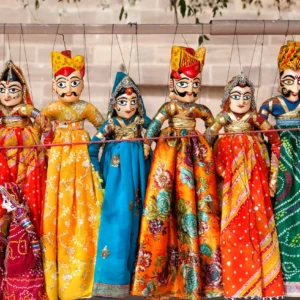The Aravalli Range is a mountain range in Northern-Western India that runs approximately 670 kilometres southwest from Delhi, through southern Haryana, Rajasthan and ending in Ahmedabad, Gujarat. Guru Shikhar on Mount Abu is the highest point at 1,722 meters. The Aravalli Range is arguably the Earth’s oldest geological feature, dating back to the Proterozoic epoch. The Aravalli Range is an important barrier to the expansion of the western desert due to its abundance of natural resources.
The Aravalli Range has been around since the days when an ocean divided the Indian Plate from the Eurasian Plate. The Proterozoic Aravalli-Delhi orogenic band in northwest India appears to have gone through a near-orderly Wilson supercontinental cycle of events, and its components are similar to those of the younger, Himalayan-type orogenic belts of the Mesozoic and Cenozoic eras.
Young fold mountains like the Himalayas are still steadily growing, but the older Aravalli has been eroded virtually to nothing over millions of years. The tectonic plates in the Earth’s crust below the Aravalli have ceased their upward drive, hence the mountains have stopped rising.
Aravalli Range Features
The Aravalli Mountain is a fold mountain produced by orogeny. The formation of the Aravalli Range is comparable to that of the Himalayas. There are rocky hills in the northern extremity of the range, which is located between Delhi and Haryana. As the location of multiple forts, the range is also of historical significance.
In Rajasthan, the two principal ranges of Aravalli are the Sambhar Khetri Range and the Sambhar Sirohi Range. The highest peak of Aravalli is Guru Shikhar, which is 1722 meters high and is located near Mount Abu. Visit these majestic while staying at our resort in Sariska.
Significance of Aravalli Range
The geological and economic significance of the Aravalli Mountains cannot be overstated. The groundwater in the area has largely replenished thanks to its efforts. As a barrier to the clouds, the range contributes to climate change in northern India. It serves as a barrier, stopping desertification from moving further east into Rajasthan. Major rivers like the Sabarmati and the Luni have their beginnings in the Aravalli Range.
Hill Stations of Aravalli Range
Abu, Rajasthan’s lone mountain town, is located on a 1020-square-meter plateau. For hundreds of years, this has been a well-known getaway from the heat of Rajasthan and nearby Gujarat. Abu is the largest optimum of the Aravalli Variety of Rajasthan’s European Indian condition. It is located in the Sirohi district.
Abu is 58 kilometers from Palanpur. These mountain types feature a unique challenging stage that is 22 kilometers long and 9 kilometers wide. Expert Shikhar has the highest optimum on the peak, at 1439 Sq. the meter above sea level
Geographical features
There are five major cratons in the Indian Craton. Cratons are a type of continental crust composed of an upper layer known as platforms and an older bottom layer known as basement rocks. Shields are sections of a craton where basement rock emerges at the surface, and they are the oldest and most stable parts that have not been affected by plate tectonics.
It consists of the Mewar Craton to the east and the Marwar Craton to the west. It is bounded in the east by the Great Boundary Fault, in the west by the Thar desert, in the north by Indo-Gangetic alluvium, and in the south by the Son River-Narmada River-Tapti River basins. The Aravalli-Delhi Orogen is dominated by quartzite, marble, perlite, greywacke, and extinct volcanoes. The Malani Igneous Suite is the largest in India and the third largest in the world.
Minerals found in the Aravalli Mountains
The Aravalli base rocks are Mewar Gneiss, which were created by high-grade regional metamorphic processes from pre-existing formations that were originally sedimentary rock with the earliest life forms formed during the Archean eon.
The tectonic development of the Aravalli Mountains reveals that Mewar Gneiss rocks are overlain by Delhi Supergroup rocks with post-Aravalli intrusions. Metal sulphide ores developed at two different times. Lead and zinc sulphide ores formed in sedimentary rocks during the Paleoproterozoic period.
The tectonic context of zinc-lead-copper sulfides mineralization in Delhi supergroup rocks in Haryana-Delhi was developed during Mesoproterozoic mantle plume volcanic action encompassing Haryana and Rajasthan.
Minerals such as rock phosphate, asbestos, apatite, kyanite, beryl, and lead-zinc-silver deposits are also commercially feasible.




